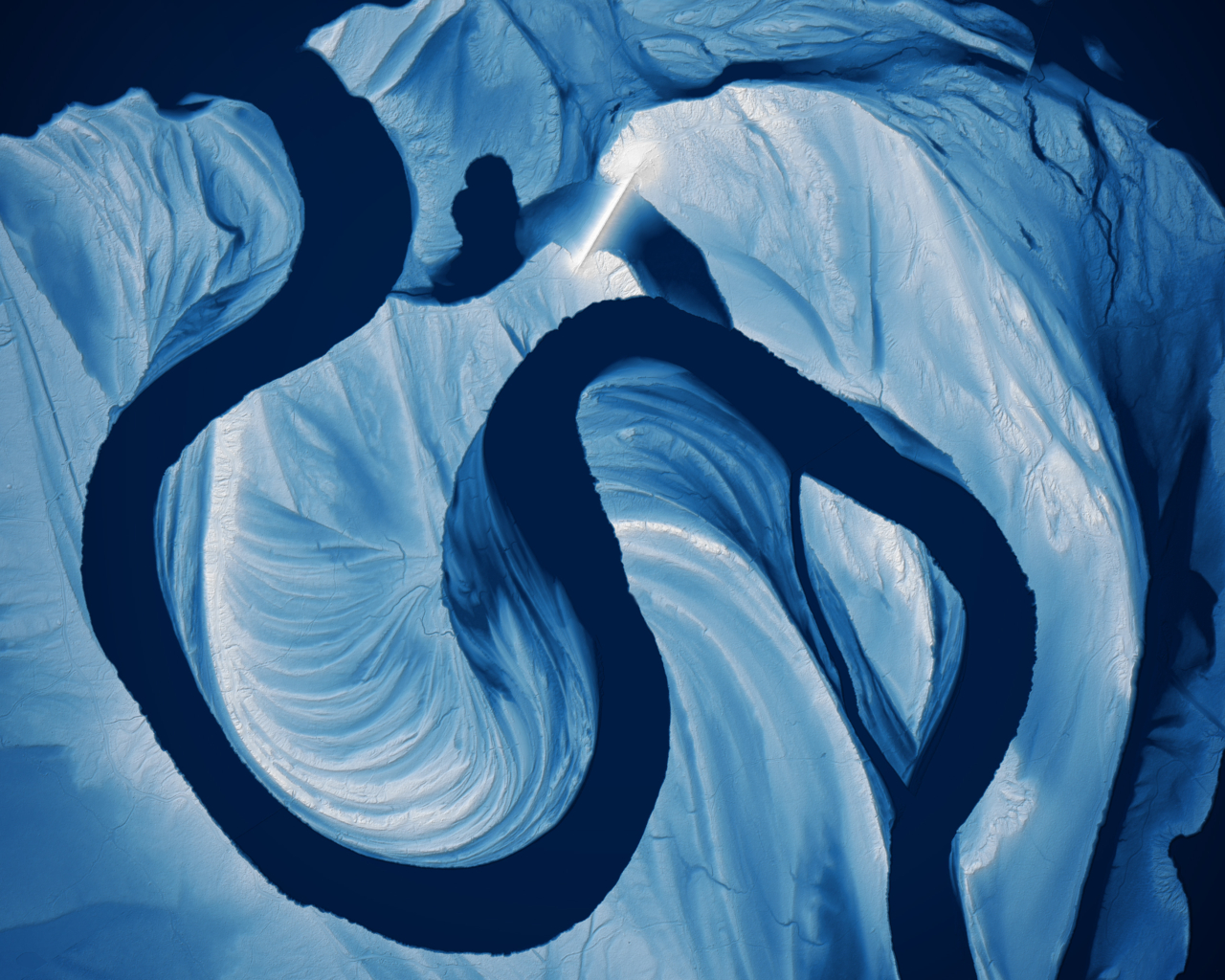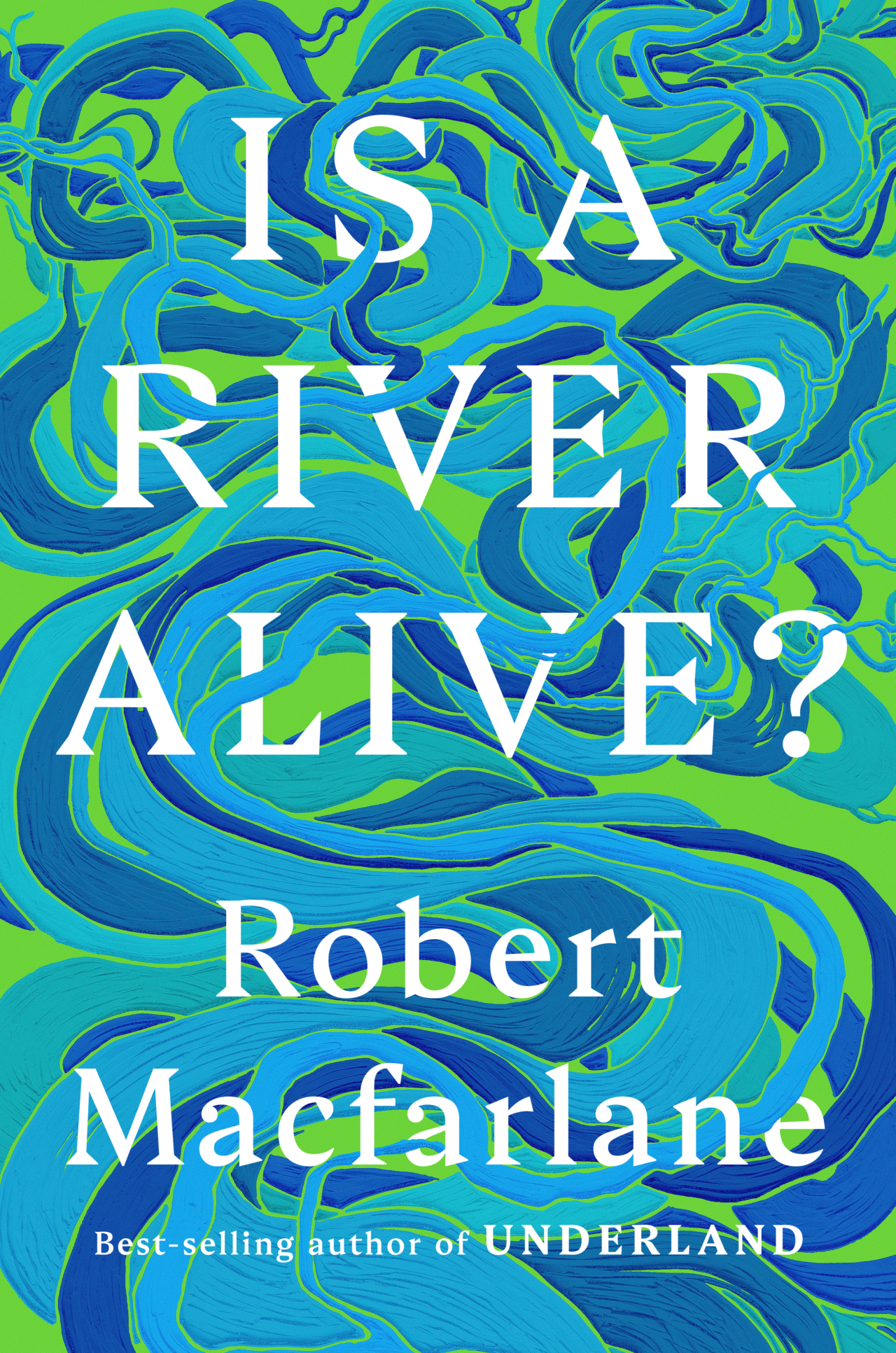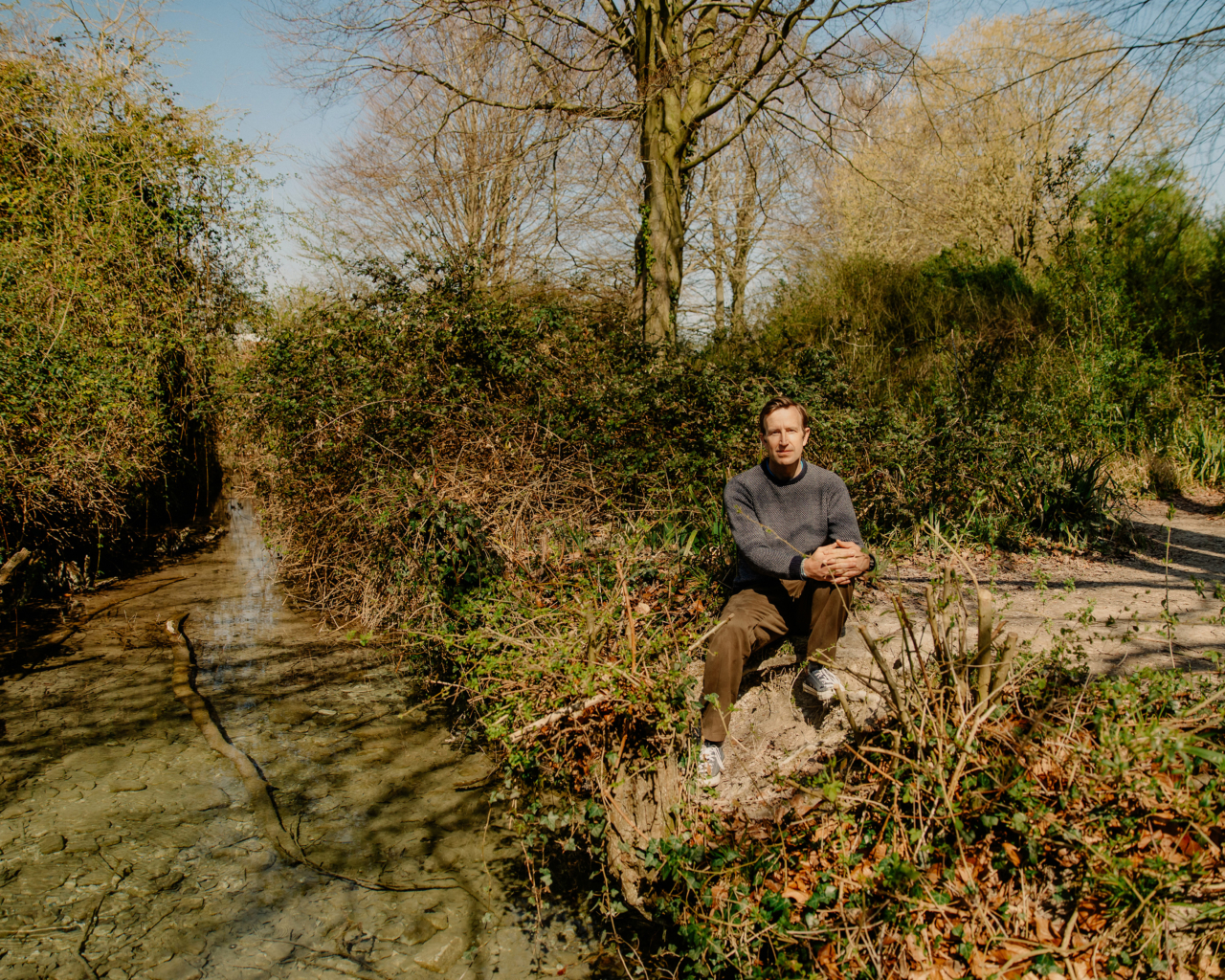

Lidar image by Daniel Coe
WORDS BY LEWIS GORDON
Robert Macfarlane says that rivers run through him. If this is the case, then surely there is a source. The acclaimed author duly points to the Cairngorms, a wilderness located high in the Scottish uplands. He recalls the River Avon, swimming in its bracingly cold, peat-flecked waters as a youngster. “We would float with scuba masks on,” he said. “What we saw were salmon. I have such a clear memory of seeing these torpedo-shaped beings that would move in the pool, hang and hold in the current, and waver in the flow.”
That was some 40 years ago. If Macfarlane were to return now, the water would still be there, but the salmon, sadly, would likely be absent. In the United Kingdom, where Macfarlane resides, the health of its rivers is declining at an alarming rate, polluted by industrial waste and depleted of oxygen and other crucial nutrients by algae (itself a symptom of the rapid heating caused by the climate crisis). Something similar is happening on every continent, from the great Mississippi River in the United States to the Ganges in India, the latter liable to give you a bacterial infection (or something worse) when you bathe in its sacred waters. Yet it was not strictly the urgent riverine crisis that inspired Macfarlane to write his new book, Is A River Alive?, but one of the responses to it: the so-called rights of nature movement. Over the past decades, this movement has gained momentum in its attempt to give rivers and other natural phenomena, like mountains, a legal voice and a means of protecting themselves in the eyes of a given country’s judiciary.
The commonly cited genesis for the rights of nature movement is legal scholar Christopher Stone’s groundbreaking 1972 paper, “Should Trees Have Standing?: Toward Legal Rights for Natural Objects.” Stone made the radical argument that legal rights should be conferred on forests, oceans, rivers, and other “natural objects” of the environment, just as rights were once extended to children, women, and non-human entities such as corporations. What started as a trickle of legal designations, with the likes of the Ecuadorian constitution in 2008, has turned into—if not quite a flood—then a gurgling brook: Rights have been granted to the likes of Lake Erie, the southernmost of the Great Lakes, and the Whanganui River, which winds majestically through 180 miles of valleys and forests of New Zealand.
Macfarlane’s own “gong” moment, as he calls it, arrived with an Ecuadorian court ruling in 2021 that deemed plans to mine for copper and gold in Los Cedros cloud forest violated the rights of nature enshrined in the country’s constitution 13 years earlier. At the time, Macfarlane was creating a work based on the ancient poem “Epic of Gilgamesh,” which sees a sacred cedar forest razed to the ground. “I remember this charge going through my whole body as I read the ruling,” he said. “I realized that this extraordinary other cedar forest, four-and-a-half thousand years later, had not been felled to the banks of its rivers, but had been saved by this form of moral imagination that we call the rights of nature movement.”

“We find ourselves in a crisis of rivers, of anima, and of life, which is born of a failure of imagination as well as a failure of legislation.”
Yet as Macfarlane points out, the book is not called Should a River Have Rights? but Is A River Alive? “The rights question,” he said, while “utterly fascinating and animating of activism and change, is really the downstream rapids of the real interest.” Around the same time, Macfarlane wrote down three questions: “Can a forest think? Does a mountain remember? Is a river alive?” For the nature writer, whose last book, Underland, led him deep below the earth’s surface, rivers presented the clearest route into these larger, perhaps knottier, ontological questions concerning non-human entities.
Language is how Macfarlane grapples with ideas. In conversation, he speaks in a nimble rush of metaphor and simile, speaking of “philosophical mists” one minute and “life’s flow” the next. On the pages of Is A River Alive?, Macfarlane’s major mission is to summon a “grammar of animacy” for rivers, a “love-language,” he writes, building on the ideas of author and botany professor Robin Wall Kimmerer. He wishes to recognize the “liveliness” of rivers when societies mostly see them as standing reserves of matter to be fished and dammed. This does not mean anthropomorphizing his watery subjects (though Macfarlane knowingly does just this at choice moments), but acknowledging what he described to me as their “astonishing, inscrutable, deeply weird presences.”
These will be heady, perhaps whimsical, ideas for many people—certainly for those in Europe and North America who were raised on a diet of post-Enlightenment rationalism. Yet for all the book’s questing intellectualism, it is a primal, sensual, and frequently swashbuckling adventure.
Macfarlane whisks readers to a river source in the teeming cloud forest of Los Cedros, along the winding currents of waterways in Chennai, India, and down the bludgeoning white-water rapids of Mutehekau Shipu, or Magpie River, in Canada. While on the journey, he deftly moves between political reportage, prose poetry, and cultural anthropology. “If the book has a form, and I certainly wanted to give it both the style and the form of water, it is that of a braided river,” says Macfarlane. “Multiple channels weaving, converging, and separating again.”

Is A River Alive? marks a turn in Macfarlane’s work. His previous books, like his 2003 debut Mountains of the Mind, were steeped in references to Romantic-era poets such as Samuel Coleridge, who came to revere the once-fearsome nature. The perspective of Is A River Alive? is oriented decisively forward: it brims with references to sci-fi and speculative fiction: Ursula Le Guin’s novel, The Word for World is Forest; Hayao Miyazaki’s animated movie, Nausicaä of the Valley of the Wind; crucially, Stanisław Lem’s novel, Solaris, about a planet whose ocean behaves in a way suggestive of something verging on agency and personhood.
The images of Macfarlane’s keenly observed prose emphasize phenomena of jaw-dropping, practically futuristic otherness (both in a positive and negative sense). He writes of teeming “ultra-life” and the staggering nocturnal beauty of bioluminescent mycelium in the Los Cedros rainforest; conversely, he witnesses bioluminescent “sea-sparkle” on the east coast of India, the result of an algal bloom feeding on pollution from a nearby sewage plant.
At another point, Macfarlane muses on how “geographies of natural rights are beginning to match up… forming continuous areas of resistance,” perhaps inadvertently plotting a path toward E.O. Wilson’s “half-earth” theory, the idea that humanity should set aside half of the planet to nature other than ourselves. But none of what Macfarlane writes of is actually invented; Is A River Alive? is not a work of speculative fiction despite referencing such works. Rather, the book reads like speculative nonfiction—a guide to the future through what is unfolding now: what is being gained and lost, and what may be won and lost in the years, decades, and centuries to pass.
“We find ourselves in a crisis of rivers, of anima, and of life, which is born of a failure of imagination as well as a failure of legislation,” said Macfarlane. His turn to stories that “dream of other worlds” was born not out of a desire to escape but out of a pressing need for instruction and inspiration. Wrestling with constructing a “grammar of animacy” for rivers, he found himself contemplating science fiction, which grapples with the unknown of alien life.
“There has been such concentrated imagination devoted to the question of how far we might be able to recognize consciousness other than our own,” said Macfarlane. “But of course, we live in a world in which we are already surrounded by alien entities, what Timothy Morton calls ‘strange strangers.’ Rivers became a way of thinking about the presence of alien entities to whom we too are alien entities.” Macfarlane likens his role to that of the scientists in Solaris who work in a field called Solaristics, recording their observations of the ocean: an “attempt,” one for which success cannot be guaranteed, to “communicate with profound otherness.”
This fundamental, possibly untraversable gap between a flowing riverine body and that of a more solid human prompts cautiousness in Macfarlane. “That’s why the book’s title is a question,” he admitted. In one section, while swimming in a pool high in Los Cedros, Macfarlane wonders: “Is this thing I’m in really alive? By whose standards? By what proof?” He continues: “Surely all our attempts to bend the law round so that it recognizes the rights of rivers or forests will only end up with human proxies… ventriloquizing ‘river’ and ‘forest’ in a kind of cos-play animism.”
“Rivers are powerful, erosive forces. They can cut a mountain in half. They can probably cut the law in half, too.”
Even having finished writing the book—which sees Macfarlane become “rivered” at its end, relayed in an ecstatic surge of liquid prose—he confesses to lingering “doubts.”
Partly, that’s the capricious nature of these ontological questions. “In a way, we will never resolve them, but we must always wrestle with them,” he said. “I also think that as soon as what we call the rights of nature movement settles into certainty and ceases to doubt itself, then it will be going wrong.” At its “best,” he asserts, referencing Anne Poelina, a Nyikina Warrwa academic and activist, it might be used to “train the law creatively.” Indeed, Poelina co-authored a legal paper concerning the Martuwarra River. The river itself, so writes the abstract, is “given agency as a published author.”
Macfarlane, for his part, exercises a playfully irreverent approach toward the law. While in Los Cedros, he and one of his companions, the musician Cosmo Sheldrake, composed “Song of the Cedars.” The track’s writing credits include the Los Cedros Cloud Forest, an audible presence in Sheldrake’s field recordings. Now Macfarlane, Sheldrake, and their colleagues are pursuing copyright and intellectual property rights through Ecuador’s legal system. They hope the cloud forest and its rivers will become the “first more-than-human entity to be recognized as the moral author of a creative work in any jurisdiction.” The goal is twofold: to emphasize a sense of “co-creation and co-authorship” with a natural object and to “knock against” the “anthropocentric” legal structures around creative works. The case hints at dizzying possibilities: Can Los Cedros derive royalties? If that’s the case, then how can a forest spend what is arguably the most human of all constructions: money?
For the past few years, the health and rights of rivers sat close to the top of the U.K. news agenda. The River Wye, which runs through Hereford, my own hometown, has become polluted with the chicken shit—a clogged-up, cloudy shadow of its formerly clear-running self. When I go running 15 minutes outside of town, I get to Breinton Springs. I sate my thirst with a deep gulp of the cold freshwater that slips out of the sandstone rock, splashing it on my warm, perspiring face. Then I cast my gaze about 50 feet to the left and see the mucky, ruined Wye.
Macfarlane’s own city, Cambridge, has prospered beside the “life-giving force” of the River Cam. But that river has also been sullied by sewage; the relationship, lamented Macfarlane, is now one of asymmetric power: “The city flourishes with little regard for the water. It’s forgotten.”
Talking about U.K. rivers, Macfarlane’s language becomes sharper and more surgical. The deep crisis that his nation’s waterways face has been laid bare by concerned residents, journalists, and activists. The culprit, he said, is “the severity of injury and the slow violence that’s been inflicted… by the sustained asset-sweating that privatization inaugurated and the capital flight, £72.8 billion [$97.5 billion USD] by one count, paid out in dividends to shareholders, many of them overseas.”
The growing and broadly supported environmental activism in the U.K. is perhaps something of a surprise, not least because of the vitriol that has often met the Extinction Rebellion and Just Stop Oil protests. “Rivers have the power to condense and concentrate,” said Macfarlane, who sees this outpouring of grief for U.K. rivers as symptomatic of larger questions of ecological harm.
The U.K.’s nature has faced a sustained onslaught for the past 250 years, with its population experiencing ever-intensifying alienation from it; by some metrics, the nation is one of the most nature-depleted and least nature-connected countries in the world. “It makes perfect sense to me that the country which first invented and then exported industrialization should be alienated and grieving in a way that the passions which rise should be very powerful ones,” said Macfarlane. “That’s why the geography of hope is often found elsewhere.”
Macfarlane began writing Is A River Alive? before the groundswell of riverine unrest in the U.K.. As such, its primary debt is to Indigenous communities and individuals across the globe who have pioneered the rights of nature movement. Yet there are places in the U.K. that map onto Macfarlane’s “geography of hope.” He points to the River Nar in Norfolk, which has effectively been healed and revived, “Lazarus-like,” said Macfarlane. “I like to use that river as a path once a year, just step into the flow and walk upstream. I’ve seen pike, kingfisher, otter, trout, and water vole in one day, the holy pentangle of chalk stream fauna.”
“When you step into that, you’re stepping back into the past of rivers in England,” he said. “But you’re also stepping into a possible future. In a sense, this, too, is a ‘speculative experience.’”
It is fitting that Macfarlane, who made his name writing about mountains, should produce a work solely dedicated to rivers. “Mountains and rivers live in this very ancient and beautiful dialectic with one another,” he said. Their relationship is both one of mutualism and slow-moving conflict. Toward the end of the book, during a scene of dusk on the bank of the Mutehekau Shipu in Canada, a companion—the artist, climber, and ultra-marathoner Wayne Chambliss—proposes a hypothesis to Macfarlane: that “earth and river are both gods made of time, but even earth has cause to fear the river.”
Perhaps, suggested Macfarlane with an impish glint in his eye, law, which typically enshrines a human-centric perspective, also has cause to fear the river. “Rivers are powerful, erosive forces. They can cut a mountain in half,” he said. “They can probably cut the law in half, too.”
Is a River Alive? is available today in the U.K. and on May 20 in the U.S.
How Recognizing the Life of Rivers Could Transform the Law

